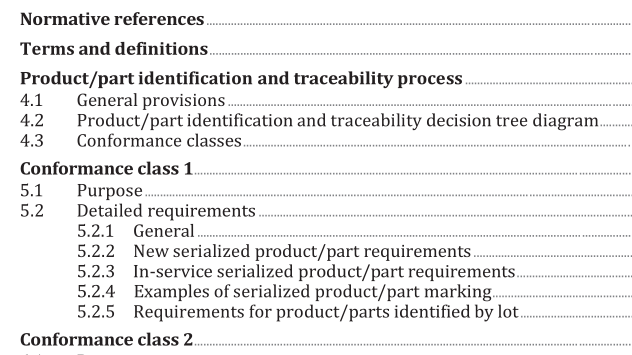ISO 21849:2022 pdf download – Aircraft and space — Industrial data — Product identification and traceability.
3.5 forward oblique stroke / special character used to separate data elements in a data string Note 1 to entry: It is character value 47 in ISO 646. 3.6 in-service product/part product/part for which the original manufacturing process, including application of the identification symbology, has been completed and which is no longer an asset of the manufacturer or portion of the enterprise which owns the manufacturing process 3.7 limited marking space space available on the product/part which is insufficient for a machine-readable symbol and associated human translation representing the essential data for the conformance class (3.2) 3.8 optional data data which is not essential to provide a unique identifier for product/part identification or configuration management/control (part number), but provides supplementary information relative to the product/ part EXAMPLE Traceability data. 3.9 syntax set of rules defining the way in which data is put together with appropriate identifiers, delimiters, separator character(s), and other non-data characters to form messages Note 1 to entry: Syntax is equivalent to grammar in spoken language. 3.10 text element identifier TEI string of four characters (three upper-case alpha characters followed by a space character) that precedes a given data field and defines the data that follow 4 Product/part identification and traceability process 4.1 General provisions In order that automated processes can be used to identify and facilitate “cradle to grave ” traceability of products/parts, a product identification and traceability schema is defined in this document. The use of text element identifiers is the preferred semantic for use in this process. GS1 application identifiers or ASC MH10 data identifiers may be used with trading partner agreement. The standard data and formats described herein are structured to be compatible/interoperable with most types of machine-readable media and human translation. Standard data formats for the identification of both new and in-service products/parts are provided.
4.3 Conformance classes Permanent machine-readable media product/part identification has two approaches to the representation of data, known as conformance classes. The conformance classes shall apply to direct part marking, labels, nameplates, RFID tags and other forms of machine-readable media. The data elements associated with the two conformance classes are specified in Tables 1 and 2 . Any stream of data complying with a conformance class specified in Table 1 or Table 2 may be input to product life cycle processes and be represented in machine-readable media. Conformance class 1 is the approach using only specified TEI data elements. Using specified well- defined data elements minimizes transmission, storage and retrieval times. Trading partners may agree on adding additional traceability data elements. conformance class 1 is intended for those products/ parts which require life cycle traceability for decades; for example, industrial products like aircraft, ships, turbine engines and conveyance power generation equipment. Conformance class 2 provides a more flexible approach which can require more marking space and time to exchange data than conformance class 1. Conformance class 2 provides examples of product/ part identifiers to be used in place of the precisely defined standardized data elements in conformance class 1. Conformance class 2 is intended for use by trading partners who have product/part identifiers already in place, for which a business case cannot be made to change to conformance class 1 specific identification requirements. Trading partners shall agree on the product/part identifiers to be used for conformance class 2 and may agree on additional data elements. Trading partners need to agree on which conformance class to employ in order to obtain interoperability between multiple users, but conformance class 1 shall be the default if no agreement is in place.
ISO 21849:2022 pdf download – Aircraft and space — Industrial data — Product identification and traceability






